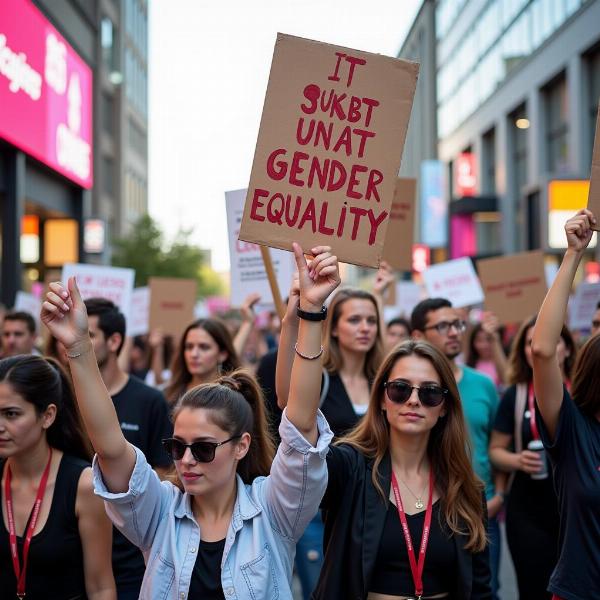Gender equality, or लैंगिक समानता (laingik samanta) in Hindi, is a fundamental human right. It signifies the equal rights, responsibilities, and opportunities for all genders. This encompasses every aspect of life, from education and employment to healthcare and political participation. Achieving gender equality is not just a matter of fairness; it’s crucial for social progress and sustainable development.
What does लैंगिक समानता actually mean?
लैंगिक समानता (laingik samanta) goes beyond simply treating men and women the same. It recognizes that different genders may have different needs and experiences, and aims to create a society where everyone can thrive regardless of their gender. This means challenging traditional gender roles and stereotypes that limit individuals’ potential. It also involves addressing systemic inequalities that disadvantage certain genders. For instance, ensuring equal pay for equal work and providing access to quality education for all girls are key aspects of gender equality.
Why is Gender Equality important in India?
In India, the concept of gender equality is deeply intertwined with cultural and societal norms. While progress has been made, challenges remain. Deep-rooted patriarchal attitudes often limit women’s access to education, employment, and leadership positions. Gender-based violence and discrimination are also significant concerns. Achieving gender equality is essential for empowering women and girls, unlocking their full potential, and building a more inclusive and prosperous India. It also benefits men and boys by freeing them from restrictive gender stereotypes and fostering healthier relationships.
How can we promote Gender Equality?
Promoting gender equality requires a multi-pronged approach. Education plays a vital role in challenging discriminatory attitudes and promoting gender-sensitive values. Economic empowerment of women through equal opportunities in employment and entrepreneurship is also crucial. Legal reforms and policy interventions are needed to address gender-based violence and discrimination. Furthermore, engaging men and boys as allies in the fight for gender equality is essential for creating lasting change. Initiatives that promote shared parenting and challenge traditional masculinity norms can contribute significantly to achieving gender equality.
What are the benefits of Gender Equality?
The benefits of gender equality are far-reaching. It leads to increased economic growth and development, as women’s full participation in the workforce boosts productivity and innovation. It improves health outcomes for both women and children, as empowered women have greater control over their health and well-being. Gender equality also strengthens democracies and promotes peace and stability. Societies that value and empower all genders are more resilient and better equipped to address complex challenges. It creates a more just and equitable society for everyone.
What are some common misconceptions about Gender Equality?
One common misconception is that gender equality means making men and women exactly the same. However, it’s about creating a level playing field where everyone can reach their full potential, regardless of gender. Another misconception is that gender equality is only a women’s issue. In reality, it benefits everyone by creating a more just and harmonious society.
 Gender Equality Protest
Gender Equality Protest
FAQ
- What is the meaning of gender equality in simple terms? Gender equality means that all genders have equal rights, opportunities, and responsibilities.
- Why is gender equality important for development? Gender equality empowers women and girls, leading to increased economic growth, improved health outcomes, and stronger democracies.
- How can I contribute to gender equality? You can contribute by challenging gender stereotypes, supporting women-led initiatives, and advocating for equal rights.
- What are some examples of gender inequality? Examples include the gender pay gap, unequal access to education, and gender-based violence.
- What is the difference between gender equality and gender equity? Gender equity focuses on fairness and justice, recognizing that different genders may have different needs. Gender equality aims for equal outcomes.
- Is gender equality achieved in India? While progress has been made, challenges such as gender-based violence and discrimination persist.
- What are the laws related to gender equality in India? Several laws exist, including the Protection of Women from Domestic Violence Act and the Sexual Harassment of Women at Workplace (Prevention, Prohibition and Redressal) Act.
Conclusion
Gender equality, or लैंगिक समानता, is not just a social issue; it’s a fundamental human right. Achieving it is essential for building a more just, prosperous, and sustainable future for all. By challenging stereotypes, promoting equal opportunities, and addressing systemic inequalities, we can create a society where everyone, regardless of their gender, can thrive. Understanding the meaning of gender equality in Hindi and its importance is the first step towards achieving this vital goal.
Meaning-Hindi.in is your trusted partner for professional Hindi translation services. We offer a wide range of translation solutions, including business and commercial document translation, certified and legal document translation, technical and user manual translation, website and localization translation, educational and academic document translation, express translation, and specialized industry translation. Need accurate and culturally sensitive Hindi translations? Contact us today! Email: [email protected], Phone: +91 11-4502-7584. Meaning-Hindi.in is committed to delivering high-quality translations that bridge language barriers and facilitate effective communication.